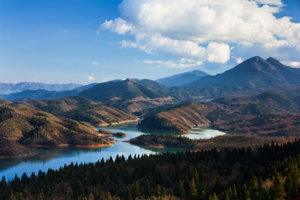
|
Folk Dance Federation of California, South, Inc.
Choreogeography: |

|
CLICK IMAGE TO ENLARGE
No other country in the Balkan Peninsula draws as much interest from westerners as Greece, for several reasons. Not only is it the "Cradle of Western Civilization," with astounding ruins proving the magnificence of its "Golden Age," the country is a major destination for tourists seeking the exotic sights and sounds of its land and people.
Perhaps this fascination of Greece evolves from the writings of Western European travelers as long ago as the 16th Century, continually embellished by those who came later. The Romantic Age of the mid 19th Century colored the stories even more, with tales of the Greeks and their Turkish occupiers. Europeans, and Americans, envisioned a place of romance and history and exotic traditions.
Folk dancers are perhaps a bit more realistic than that; after all, they are interested in the dance and music of Greece just as they are of any other country. But many who do not dance and never heard of a "syrtos" find their aesthetic buttons pushed by the multifaceted sounds of Greek music. It is small wonder that motion pictures of Greece, "Zorba," "Never on Sunday," and others are remembered mostly for their wonderful music which falls favorably on western ears.
Greece is one of the most diverse countries of Europe, having perhaps more coastline than any country of its size anywhere. The sea intrudes deeply into the interior and a provides a living to a large number of the people. Rugged interior mountains divide isolated valleys and rocky soils yield little to the farmer or the herdsman over much of the land, long since denuded of trees by Venetian ship builders centuries ago. Sheep and goats and olives seem to be the major agricultural products.
The ethnic regions of Macedonia and Thrace spread their southern areas into northern Greece. Gentle Epirus and rocky Thessaly complete the northern part of the country; Central Greece extends south and ends in a point with Athens and its port city of Pireus. Extending to the west, the slender Isthmus of Corinth leads to the ancient site of Sparta, the Peloponnesus, now turned to an artificial island by the Corinth Canal.
The balance of the Greek world is comprised of its many justly famous islands, each with its own distinct culture: Crete, Kafilonia, Rhoades, Lesbos; names which evoke echoes of ancient gods and heroes.
Dance permeated Greek society throughout its history, though modern industrial life has destroyed and altered much of it. Dances we think of as "Panhellenic" have spread over the country only recently with mass communication and migration to the cities. Formerly, each tiny village and valley had its own dances with its own musicians and songs.
It is truly unfair to both reader and writer to attempt to describe the complexity of Greek dance in so small a space. One can only be amazed by the unending flow of dances brought to us by Greek teachers. It is worthwhile, however, to identify a few of the dances most frequently encountered and to take a look at what they represent.
"Vari hassapikos" ("heavy" hassapikos) was originally known as the "fisherman's dance" and is traditionally danced by two or three men, each improvising the dance as he leads it, dancing in his own movement style, followed with perfect imitation by his fellows. When leaders change, so does the dance, often dramatically, as the new leader dances his favorite figures in his own personal style. The dance is one of the most intimate of all folk dances, it is shared by these two or three men and it would be unthinkable for another to join them.
"Hassaposerviko" is the "light" hassapikos, moving quickly and lightly to the right in a more open and welcoming dance.
Of course, "syrtos" and "kalamatianos" are well-known to Greeks and folk dancers alike and differ primarily in rhythm; the "syrtos" ("dragging") is in an even 2/4 meter, while the "kalamatianos" (from "Kalamata") is a livelier 7/16 rhythm.
"Tsamikos" is an interesting dance, appreciated more by the dedicated dancer than the beginner for its hypnotic, yet seemingly uninteresting figure. Watch, carefully, for you will see the dancers from the rural mountains lift the leg high for each step, while those from the city will skim across the smooth floor in a quick, almost nervous movement.
Take a good look at a Greek class. Watch for the schedule of Greek festivals, and join in the fun and fascination of Greek dance.
Used with permission of the author.